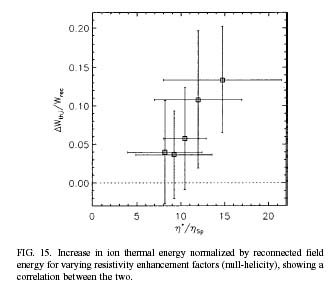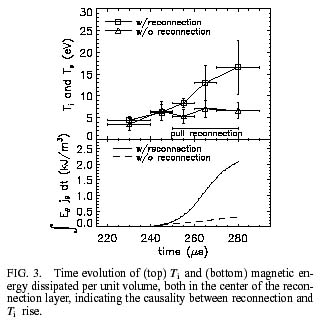Experimental Study of Ion Heating and Acceleration During Magnetic Reconnection
Ion heating and acceleration has been studied in the well-characterized reconnection layer of the Magnetic Reconnection Experiment [M. Yamada et al., Phys. Plasmas 4, 1936 (1997)]. Ion temperature in the layer rises substantially during null-helicity reconnection in which reconnecting field lines are anti-parallel. The plasma outflow is sub-Alfvénic due to a downstream back pressure. An ion energy balance calculation based on the data and including classical viscous heating indicates that ions are heated largely via nonclassical mechanisms. The Ti rise is much smaller during co-helicity reconnection in which field lines reconnect obliquely. This is consistent with a slower reconnection rate and a smaller resistivity enhancement over the Spitzer value. These observations show that nonclassical dissipation mechanisms can play an important role both in heating the ions and in facilitating the reconnection process.



Local Measurement of Nonclassical Ion Heating During Magnetic Reconnection
Local ion temperature and flows are measured directly in the well-characterized reconnection layer of a laboratory plasma. The measurements indicate strongly that ions are heated due to reconnection and that more than half of the reconnected field energy is converted to ion thermal energy. Neither classical viscous damping of the observed sub-Alfvénic ion flows nor classical energy exchange with electrons is sufficient to account for the ion heating, suggesting the importance of nonclassical dissipation mechanisms in the reconnection layer.
